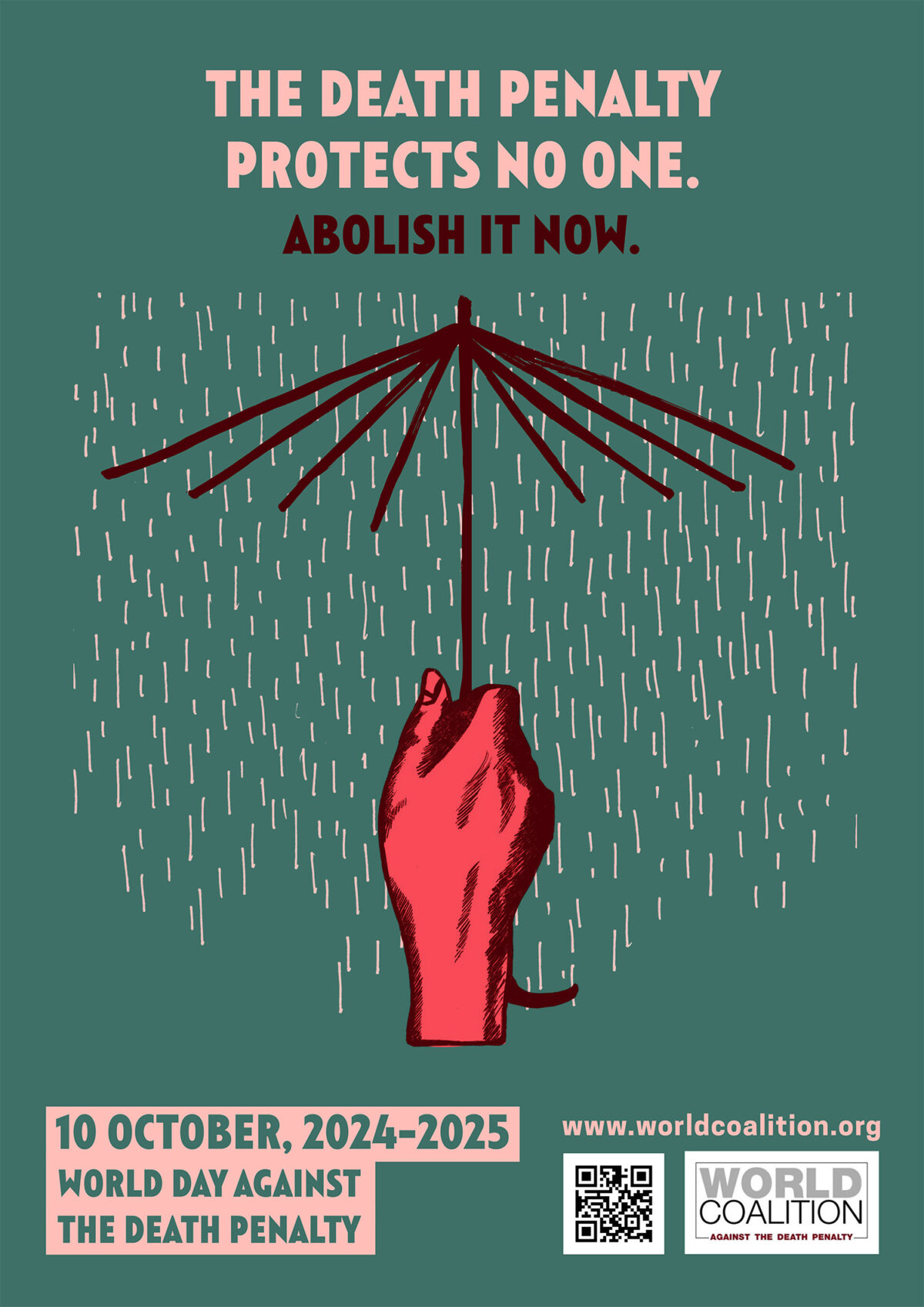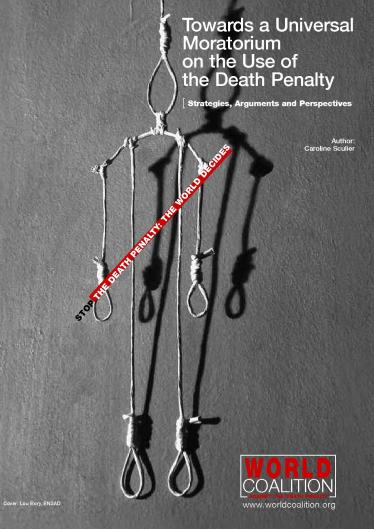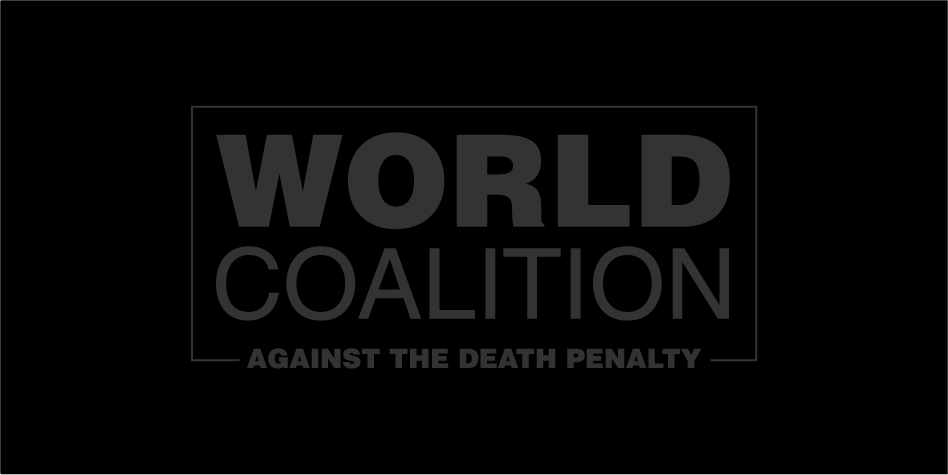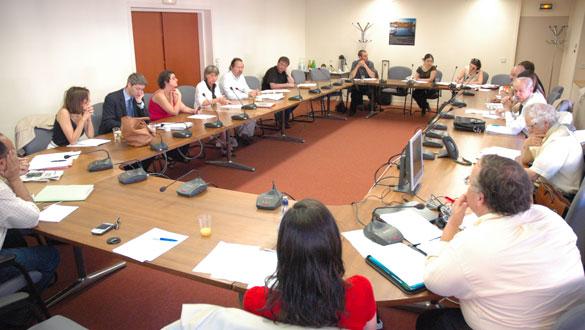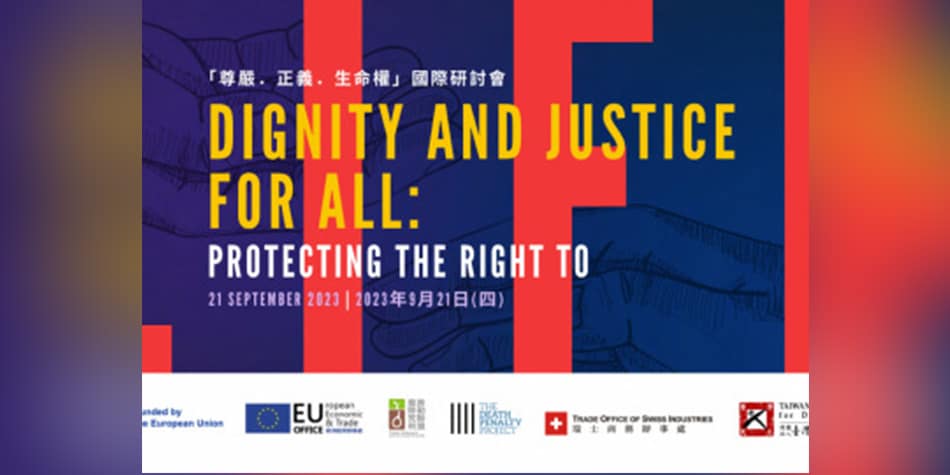
International Symposium on the Right to Life in Taiwan
Asia
The Taiwan Alliance to End the Death Penalty (TAEDP) held a series of events including an international seminar, prison visit, and meetings that took place from 19-22 September 2023 to celebrate its 20th anniversary.
Scholars, NGO workers, and government representatives from the United Kingdom, the United States, Switzerland, Lithuania, India, South Korea, Malaysia, and Taiwan exchanged about the research on the treatment of death row prisoners in Taiwan, the development of legislation protecting the rights of victims, and constitutional litigation related to the death penalty across different countries.
The following blog post was first published by Taiwan Alliance to End the Death Penalty (TAEDP), 20 November 2023, translated into English by The Death Penalty Project on 14 December and edited and translated in French by the World Coalition on 18 December.
Taiwan Death Penalty Prison Interview Project
In order to gain a deeper understanding of criminals’ life characteristics, prison conditions, and possible waiting-for-death phenomena, Taiwan Alliance to End the Death Penalty conducted comprehensive interviews with all people currently on death row in Taiwan. The research team has issued an interim report to explain the current preliminary findings. At the same time, it has communicated with experts from all walks of life and compiled relevant suggestions, so that subsequent research and interviews can have more solid results.
Lin Xinyi, CEO of the Alliance to Abolish Death, said that when the Alliance was first established 20 years ago, it wanted to investigate and reconstruct the life of death row prisoners. However, at that time, they had no idea where the death row prisoners were, and only the Executive Yuan in the country knew. It was not until 2020 that the research was launched in cooperation with the Alliance for the Abolition of Death, the Human Rights Protection Promotion Group of the Executive Yuan, and the Correctional Services Administration of the Ministry of Justice. This project hopes to present the growth, background, life and treatment in prison of death row prisoners and life sentence prisoners as a control group; it is hoped that the results will eventually be compiled into policy recommendations for the government’s reference, so that in the future, long-term prisoners can receive more appropriate situation.
Research methods
Lin Xinyi emphasized that this study was not commissioned or censored by the government and was self-funded, and the interviewees were relatively willing to tell the truth. The interviewees included thirty-seven death row prisoners and forty-three life-sentence prisoners. Quantitative questionnaires and qualitative interviews were conducted on them. An institutional questionnaire was also designed for prison managers to fill out. The research team asked former death penalty exonerees to review it in advance to confirm that the question design was effective and understandable. The implementation method is to provide informed consent before meeting with the interviewee for the first time, explain the content and risks of the plan, confirm the willingness, and let the interviewee know that the interview space is independently separated, and the prison can only watch it and cannot be in it. Surveillance recording; the entire interview process will be recorded for accuracy and analysis, and the data will be kept anonymous and confidential and destroyed at the end. Lin Xinyi said that several death row prisoners took the initiative to express their hope not to be destroyed, because this may be their only remaining audio and video record in the world.
Basic data analysis: Before becoming a death row prisoner
This interim report only presents information on death row prisoners. More comprehensive content will not be released until all interviews are completed and analyzed. According to interview data from death row prisoners, nearly 30% of the 37 prisoners are over 60 years old, with the oldest being 71 years old. More than 70% of them have not graduated from high school, and more than half are in prison for the first time. The average age at the time of committing the crime is 30 years old, and the average time in prison is about 20 years. These interviewees generally lacked stable and close caregivers when they were young, and their parents and elders were busy with work. They encountered corporal punishment or bullying at home or at school, which made them prefer to leave home or school early, but their working conditions were unstable. Some people will meet friends of mixed brothers in juvenile reformatory schools, correctional training teams or other places. “I am envious when I see them living such a good life.” The various conditions of their growth make them unknowingly become tightrope walkers. If you are not careful, you will fall. Low psychological flexibility and lack of emotional resources are also aspects worth noting; many people impulsively commit crimes because they cannot control their emotions in the moment of a dispute.
On July 1, 2006, the Criminal Law was revised. A life sentence prisoner must be incarcerated for 25 years before he can apply for parole. Before that, it was 15 years. Among the 37 death row prisoners we interviewed, 26 committed crimes before the new law was implemented. If they were sentenced to life imprisonment, almost all of them would be able to apply for parole now. In addition, there was no assessment of circumstances, pre-sentencing social investigation or Children’s best interests. That is to say, if we judge according to the current judicial quality, , they are likely not to be sentenced to death; this also reflects the arbitrariness of the death penalty.
Daily life in prison
Professor Ciwang Teyra from the Department of Social Work at National Taiwan University went on to say that the interviewer team worked hard to make the wording of the quantitative questionnaire questions more realistic and prepared graphic hand cards so that the respondents could better understand the meaning of one to five points. The interviewees all mentioned that their eating conditions were very poor, and some even ate wire from their dishes. The water quality is even more worrying. Bathing and drinking water are often dirty, causing them skin allergies and diarrhea. Prison cooperatives can purchase basic daily necessities, but the supply is unstable and orders can be canceled arbitrarily. The aging of prisoners and the issue of long-term care have also been ignored. Their teeth and health have deteriorated, but their diet cannot be adjusted accordingly; the health foods available to buy are very limited.
Death row prisoners live in a space of less than two square feet, and they can only go out to the corridors when they meet friendly management staff. If you want to write calligraphy or draw Buddhist statues, you can only kneel in the narrow room. There are no partitions between sleeping and bathing areas, water needs to be stored at fixed times during the day, the dormitories are damp, and almost everyone suffers from eczema. The light and noise in the prison are very disturbing to sleep. In fact, these living conditions can easily bring about diseases, but the authorities do not like to see external doctors for treatment. They usually only give basic drugs to suppress symptoms, and it often takes more than half a month to apply for an external doctor.
The psychological consultation arranged by the agency only lasted 20 minutes and was difficult to achieve results. The regulations stipulate that there is one hour of time to go outdoors every day, but in fact not every prison can achieve this. Although there is no limit on the number of family visits, they can only see friends twice a week. Ciwang used the analogy of people living in school dormitories. Death row prisoners will be kept together with short-term prisoners or detained defendants, so they have to adapt to new roommates all the time. Newly admitted roommates usually have nothing, so they need to be given some assistance. It is a burden to death row prisoners. People on death row believe that if there is a plan to live alone or in a special area, their status will be relatively stable. On the surface, there are channels for complaining about unreasonable matters, large and small, in prisons. In fact, the appeal mechanism is not smooth, and it is difficult to bring about substantial changes. Many norms test and weaken the physical and mental health of people on death row.
The phenomenon of waiting to die: living with this identity
Professor Huang Songli, director of the Policy Center of the Alliance for Supervision of the Implementation of the Human Rights Convention, extracted the content repeated by the interviewees and conducted thematic analysis based on the verbatim transcripts of the interviews. He said that the death penalty is not just an abstract policy, but also encompasses the daily realities of life for those sentenced to death. Many classmates on death row mentioned that their sense of time remained unchanged and without progress, just living one day at a time. The general public often says that prisoners spend taxpayers’ money and eat free prison meals. In fact, most of their daily expenses in prison need to be supported by relatives and friends, so the interviewees feel like they are a burden on their families.
Ciwang said that death row prisoners are not allowed to go to work with other prisoners, so unlike other prisoners who have labor and income, many interviewees want to earn some allowance on their own, learn a skill, or make up for the families of the victims. But the most the prison allows them to do is bring their work back to the dormitory, and the space of more than one square meter has to be filled with utensils. For example, one of the common tasks in the prison is origami lotus flowers. If you do it every day, you can get more than a thousand yuan per month at most. The labor money will also make the narrow dormitories dirty and crowded. Various reasons reduce the willingness of death row prisoners to participate in labor. Huang Songli echoed that living a self-reliant life will bring dignity, but the prison system is depriving them of the opportunity to work and causing death row prisoners to lose the meaning of their social roles. “Whether you want to send me to guard nuclear waste or go to the battlefield, let me do things. I think this is what a human being is.” More than one classmate gave similar feedback.
Facing execution
In the early years, after the death penalty was established in Taiwan, executions would be carried out within a few days. The execution was so fast that people were caught off guard. The interviewees said that facing the torture of long waiting now is not much better. Waiting without dignity and without knowing the end is more painful than death itself. The huge uncertainty and procrastination made them prefer to die quickly rather than be locked up there without hope and live a miserable life, which was tantamount to being wasted. They even feel that their lives are being used as political tools to eliminate social dissatisfaction. Several classmates have religious beliefs and say they are not afraid of death, but they care about their families. During the long period of imprisonment, many people watched their fellow prisoners being dragged out and executed. How to accompany the person who is about to die, and how to adjust themselves, is another situation that bites their nerves.
Some people on dearth row said that they could have arranged dormitory rooms, but after a new supervisor, they were asked to strip away all their hard work. Long-term detainees lack autonomy in their lives. They have to eat, sleep and wait to die every day. The phenomenon of waiting to die and the accompanying sense of lack of autonomy are the keys to easy access to mental illness. Many classmates of death row prisoners have difficulty sleeping, depression, and obsessive-compulsive disorder. There are many people who have attempted suicide and were later controlled with psychiatric drugs, but ended up in a drug-induced state where they were unable to truly feel themselves.
Interestingly, many death row prisoners expressed support for the death penalty system, but the trial must be fair. Many felt that they did not receive reasonable treatment during the judicial process. For example, favorable evidence was not admitted, and there were even death row prisoners who were still innocent. Even if they are not expressing opinions on their own case, they have seen the plight of other death row prisoners and feel that judges should pay more attention to the background of the defendants, especially those who are committing crimes for the first time. Huang Songli pointed out that many people will say to the judge: “Just sentence me to death.” This is actually a protest against the process, because they have been misunderstood and disrespected in the law enforcement process, and they want to end the pain as soon as possible. The current correctional institution environment and correctional resources are extremely lacking, which is also a thorny issue; how the judiciary declares whether a person has the possibility of correction requires more discussion and empirical investigation.
India’s death row prisoner survey
Maitreyi Misra is the mental health and criminal justice director of India’s Project 39A. She said that there are currently about 550 death row prisoners in India, and 165 people have been sentenced to death in 2022 alone. The information she shared, however, comes from the Indian Death Penalty Report released in 2016. The project was conducted between 2013 and 2015, and 370 people sentenced to death were interviewed. Among this group of people, 63% are the only source of income for their families, and about 60% have not received a secondary school education. Most of them come from the bottom of society. Moreover, India has a caste system, which shows the impact of religion and social class on death penalty trials. Maitreyi said that during the planning process, some people were later acquitted or had their sentences commuted, which showed the arbitrariness of the trials.
Another study ‘Assessing the death penalty in India from a mental health perspective, it can be seen that a high proportion of death row prisoners have “childhood adversity experiences” , a death row prisoner recalled how he gradually became addicted to drugs and suicidal after witnessing his father breaking his mother’s hand as a child. 62% of death row prisoners in India have mental illness and 11% are intellectually disabled. Their psychological state, whether it existed before committing the crime or was caused by long-term detention after committing the crime, has not been taken seriously.
Maitreyi depicts the conditions of death row and incarceration of death row prisoners in India. There is insufficient light in the prison, and the living environment is also very poor. Even so, some death row prisoners come from extremely poor families and can only eat one meal a day since they were young. They may even feel that they are better off in there, at least they will not go hungry. More than half of death row prisoners in India have attempted suicide. A prisoner said that after he learned that he was sentenced to death, it felt as if his white prison uniform was going to bite him to death. Another prisoner on death row was allowed to draw in prison. After this activity was cancelled, he began to want to die and wanted to go into the kitchen and burn himself with hot oil. There is also a death row prisoner who seeks death. He has been in solitary confinement for six years. In addition to not knowing when he will be executed, he is also worried that his body will be thrown out and bitten by dogs after death.
Maitreyi said that the proportion and number of women sentenced to death in India is higher than that in Taiwan. A female death row prisoner was very lively and loved to dress up before entering prison, but the prison administrator said: “Your family thought you were dead, and they didn’t even want to see you.” She fell into a deep depression. Taken together, the mental health problems faced by death row prisoners in India are also severe. Lin Xinyi responded that Taiwan’s Ministry of Justice will arrange psychological counseling for death row prisoners, but interviewees do not want to be stigmatized or regarded as people with problems; more importantly, if the living environment does not improve, counselors cannot provide guidance. What a magical change.
Forensic psychiatry in the UK
Richard Latham from the UK serves as a forensic psychiatry consultant and gets along with and works with prisoners in British hospitals. He said that judging from the situations in Taiwan, India and the United Kingdom, if a person has psychological and mental problems, he is more likely to face the death penalty. If there is a mental problem, how can the lawyer present opinions on behalf of the client? This is a difficult problem. Because mental problems are the result of trauma, these offenders face the stigma of mental illness. In addition, they are often unable to establish substantial relationships with people and cannot trust others, making it difficult to interact well with lawyers. These personality disorders make it difficult for them to be impartial. Use justice appropriately. If the offender is in poor physical and mental condition and shows no repentance and unwillingness to apologize, it will also affect whether he is sentenced to death.
Richard admitted that psychiatry has its limitations. When a psychiatrist determines that a person cannot be educated, it means that he cannot be treated pathologically and may be dangerous, but it does not mean that he has no other ways to heal or become better, because this person may have suffered complex trauma. . Moreover, psychiatry diagnoses based on the patient’s reaction rather than relying on their true psychological quality. For example, people with intellectual disabilities often hide themselves and want to show their capable side. Psychiatrists cannot always immediately identify people with mental disorders; so if the death penalty continues, there may be “unrecognized” people with mental disorders sentenced to death.
When the audience asked questions, Richard specifically added that British prisons are divided into different areas, and prisoners with psychological problems will be separated; prison managers can face them with different mentality and will not demonize them. In addition, judicial hospitals in the UK are indirectly managed by the national health department. There are about 90,000 medical and security personnel in judicial hospitals across the country, and there are about 7,500 beds. If the prisoner’s condition is not good in prison, he will go to the judicial hospital. But running a judicial hospital costs twice as much as a regular prison, and the state’s correctional system must be open to negotiation before alternatives to prison are possible.
The significance of studying death row prisoners
Lawyer Saul Lehrfreund, executive director of the UK’s “Death Penalty Project”, mentioned that they have conducted similar research in Bangladesh and Kenya, Africa, and have many common findings with Taiwan and India: most death row prisoners are disadvantaged, have low education and income, and have negative childhood experiences. Or have a mental disorder. Starting from objective data and information like this and reconstructing each person’s background and experience, we can clearly see that death row prisoners are human beings, and the death penalty deprives humanity and dignity. It’s important to tell these people’s stories because any discussion of the death penalty dehumanizes them. Saul reminded that these studies are creating new discourses, changing the atmosphere of social dialogue, and dismantling public stereotypes.
Finally, Saul shared that he once heard a death row prisoner who had been waiting for death for fourteen years say this: “Get up and open your eyes every day. I died once, day after day.” The sentence of death does not only include execution, but is worse than the execution itself, because the phenomenon of waiting to die is a more prolonged and heavy torture.


